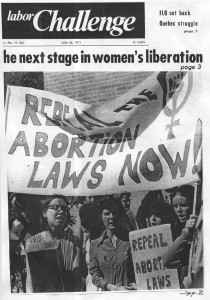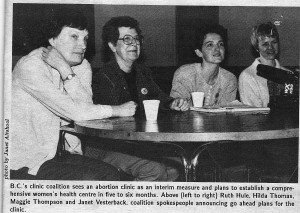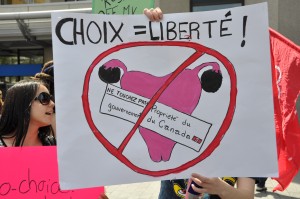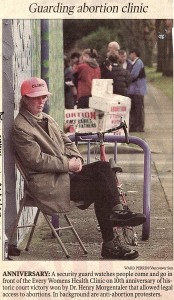Timeline
1869: Abortion is made illegal by Parliament, under the threat of life imprisonment. Dissemination of information about birth control is also made illegal.
1892: Parliament enacts the first Criminal Code, which prohibits abortion and the sale, distribution, and advertisement of contraception.
1923, Jul 2: Margaret Sanger speaks in favour of contraception at the Women’s Building on Thurlow Street in Vancouver. Meeting organized by Women’s International League for Peace and Freedom.
1926 to 1947: 4,000 to 6,000 Canadian women die as a result of bungled illegal abortions.
1930’s – 1940’s: Activist Ruth Bullock of Vancouver helps women get illegal abortions.
1936: Social worker Dorothea Palmer is arrested and charged under the Criminal Code with offering birth control information.
1948: Dr. Robert McCallum begins doing abortions in BC and continues until he is arrested, about 1967.
1959: 33,000 estimated abortions are performed in Canada this year alone. Others estimate as many as 120,000 a year occurred between 1955 and 1969.
1961: Woman jailed for 8 years for performing abortion on woman who died (just one of many examples).
1962 to 1968: Most documented deaths from illegal abortion in one year during this period is 400. Actual numbers probably much higher.
1963: Canadian Medical Association starts to lobby the government to change the abortion law.
1965 – 1969: Sixty-one women known to have died from abortions.
1966, Feb 19: A Toronto doctor (identity not known) urges a legal abortion law, claiming that somewhere between 25,000 and 75,000 criminal abortions are performed yearly in Canada.
1967, Oct: federal committee (Standing Committee on Health and Welfare) considers amendments to Criminal Code. Three different bills presented. Dr. Henry Morgentaler presents brief on behalf of the Humanist Fellowship of Montreal.
1967: 35,000 to 120,000 illegal abortions yearly.
1967: Justice Minister Pierre Trudeau tables bill to ease laws against abortion and divorce, and decriminalize homosexuality and contraception.
1968, Jan 9: Dr. Henry Morgentaler defies section 251 of the Criminal Code and performs abortions in his medical practice in Quebec. Full-time abortion practice by March 1969.
1968: McGill students Donna Cherniak and Allan Feingold produce and publish first handbook about contraception, before distributing such information was legal.
1969, March: Standing Committee on Justice and Legal Affairs hears testimony from many people and groups on criminal abortion law amendment.
1965 to 1968: Dr. Les Smoling operates illegal clinic in Toronto called the Toronto Free-Standing Abortion Clinic. He was charged three times, eventually left country and didn’t return till 1979.
1967: A federal committee considers amendments to the Criminal Code on abortion. The committee hears from many groups and individuals on both sides of the issue, including Dr. Henry Morgentaler, who urges repeal of the abortion law and freedom of choice on abortion.
1969, Aug 28: Parliament enacts Omnibus Bill law by vote of 149 to 55. Section 251 of Criminal Code amended, decriminalizing abortion under certain limited circumstances. Some hospitals with Therapeutic Abortion Committees can approve and provide an abortion, if the pregnancy would endanger the woman’s life or health. Access to abortion is applied unevenly and unfairly across the country and women wait an average of 8 weeks for an abortion. The omnibus bill also legalizes contraception.
1970, April – May: The Vancouver Women’s Caucus organizes the Abortion Caravan, the first national feminist protest. Women travel over 3,000 miles from Vancouver to Ottawa, gathering numbers as they go. In Ottawa, the Abortion Caravan, now 500 women strong, holds two days of demonstrations. Thirty women chain themselves to the parliamentary gallery in the House of Commons, closing Parliament for the first time in Canadian history.
1970, June: Morgentaler’s office is raided by the police and he is charged with conspiracy to perform an abortion.
1970, December: The 1967 Royal Commission on Status of Women releases its final report recommending that the Criminal Code be amended to permit abortion on request in the first 12 weeks.
1971 – 1973: Ten more criminal charges are laid against Dr. Morgentaler. In Nov. 1973, a Montreal jury of 11 men and one woman acquit Morgentaler. Quebec Court of Appeal overturns jury verdict and finds Morgentaler guilty in 1974. He appeals his case to the Supreme Court of Canada.
1973: Morgentaler issues a public statement in March saying he is performing abortions. On May 13, he performs an abortion on TV (W5). Film is seized by authorities for use by prosecution.
1974: The Canadian Association for the Repeal of the Abortion Law is founded, the first national group promoting abortion rights in Canada. (Renamed to Canadian Abortion Rights Action League in 1980).
1975: Quebec Court of Appeal votes 6-3 to uphold the Quebec Court’s conviction and Morgentaler is sentenced to 18 months in prison. While serving his sentence, he is tried on a second charge. A jury acquits him again, and the Quebec Court of Appeal upholds that acquittal.
1976: The Federal Minister of Justice sets aside Morgentaler’s conviction on the first charge and orders a new trial. Morgentaler, who had suffered a heart attack in jail, is freed after serving ten months of his sentence. In September, he is acquitted at the retrial of the original charges, the third time a jury acquits him. In late 1976, the Quebec government drops all further charges against Morgentaler.
1976, Nov: Morgentaler begins to train doctors to provide abortions, training about 30 over the next few years.
1977, Feb: The Badgley Committee report is released, finding that women face average delays of 8 weeks for an abortion, law discriminates against poor and rural women, and “health” is interpreted arbitrarily.
1977 – 1978: Several clinics and women’s health groups petition provincial governments to establish legal abortion clinics in Ontario and Manitoba, but fail.
1982: Prince Edward Island refuses to fund abortions and all hospitals stop providing the service.
1982: Only 261 of 861 public hospitals in Canada have Therapeutic Abortion Committees.
1982, Sep 28: Ontario Coalition for Abortion Clinics forms.
1983: Dr. Morgentaler opens illegal clinics in Toronto and Winnipeg
1983 – 1985: Morgentaler’s Winnipeg and Toronto clinics are raided several times by police. Dr. Morgentaler is charged with conspiracy to procure a miscarriage, along with other doctors. At the 1984 trial, everyone is acquitted.
1985, Oct: The Ontario Court of Appeal sets aside the 1984 jury acquittal and orders a new trial. Dr. Morgentaler appeals to the Supreme Court of Canada.
1986: Canadian Abortion Rights Action League organizes tribunals across country, putting abortion law on trial.
1986, May 25: Dr. Robert Scott and Maria Corsillo open the Scott Clinic in Toronto. Dr. Scott was arrested in September, but the charges were later stayed by the Attorney General.
1987: The BC Coalition for Abortion Clinics is founded to establish clinics in BC. (Renamed the Pro-Choice Action Network in 1998.)
1988, Jan 28: The Supreme Court of Canada strikes down Canada’s abortion law as unconstitutional. The law is found to violate section 7 of the Charter of Rights and Freedoms because it infringes upon a woman’s right to life, liberty, and security of the person.
1988, Feb: Various provinces announce different public policies on abortion in an effort to restrict the service or flout the Supreme Court decision, including BC, Saskatchewan, Nova Scotia, and New Brunswick.
1988, Aug 22: The Canadian Medical Association approves a policy recognizing the right to abortion on request up to the 20th week, with abortions after that done at doctors’ discretion “under exceptional circumstances.” Also approves abortions outside hospitals, and full Medicare coverage for all abortion services.
1988 – 1994: Many new clinics open, including the Choice in Health Clinic in Toronto (1988), Everywoman’s Health Centre in Vancouver (1988), Cabbagetown Clinic in Toronto (1989), Morgentaler Clinic in St. Johns NF (1990), Morgentaler Clinic in Edmonton (1991), Elizabeth Bagshaw Women’s Clinic in Vancouver (1991), Kensington Clinic in Calgary (1992), Morgentaler Clinic in Fredericton (1994), and Morgentaler Clinic in Ottawa (1994).
1989: Operation Rescue begins clinic blockades in Toronto and Vancouver.
1989, March: The Supreme Court of Canada refuses to decide on the claim of Joe Borowski that fetuses have a constitutionally guaranteed right to life, saying his case was moot, due to the abortion law being struck down.
1989, Jul – Nov: In Manitoba, Ontario, and Quebec, ex-boyfriends try to get injunctions to stop their former girlfriends’ abortions. Chantal Daigle of Quebec is refused an abortion under an injunction and appeals to the Supreme Court. During the August hearing, the court learns that Ms. Daigle has already had an abortion in the U.S., but overturns the injunction against her anyway. In November, the court releases its reasons, unanimously ruling there is no fetal or paternal right to stop an abortion, and that a fetus is not a human being and has no right to life.
1989, Oct 26: Dr. Morgentaler opens a clinic in Nova Scotia after the provincial government passes legislation prohibiting abortions at clinics. The next day, he is charged under the provincial Medical Services Act. In 1990, a provincial court strikes down the Act as unconstitutional and acquits Morgentaler.
1989, Nov 3: The federal government introduces Bill C-43, an amendment to the Criminal Code that would prohibit abortion unless a doctor finds the pregnancy is a threat to the woman’s physical, mental, or psychological health.
1990, May: The House of Commons passes Bill C-43 and the legislation is sent to the Senate for approval.
1990, June 12: Yvonne Jurewicz of Toronto dies of a self-induced coat-hanger abortion, apparently believing that abortion is already illegal.
1991, Jan 31: Bill C-43 is narrowly defeated by the Senate in a tie vote. Abortion is now treated like any other medical procedure.
1990’s: The anti-choice movement and individual activists begin numerous campaigns to restrict or stigmatize abortions and terrorize providers, including: home picketing of doctors, harassment, compiling “hit lists” of doctors, sending hate mail and threatening packages, stalking and death threats, aggressive picketing of clinics, violating bubble zones and injunctions outside clinics, vandalism and violence, arsons and bombings, frivolous lawsuits, attempts to defund abortion, private member bills and motions, petitions, offensive public displays of alleged aborted fetuses, “40 Days for Life” protests outside clinics, opening deceptive “crisis pregnancy centres,” advertising campaigns, commissioning misleading polls, annual “Life Chains” and “Marches for Life”, and other actions.
1993, Dec: Dr. Ellen Wiebe starts performing methotrexate abortions in her office in Vancouver, as part of a clinical study. Methotrexate abortions continue to be available in Canada today.
1994, Jun: New Brunswick invokes Medical Services Payment Regulation prohibiting doctors from performing abortions outside approved medical facility. NB College of Physicians and Surgeons restricts Dr. Morgentaler’s licence. In September, NB Court of Queen’s Bench rules that province has no right to restrict abortions to hospitals.
1995, Jan 6: Federal Health Minister Diane Marleau gives an ultimatum to provinces: they must pay full costs at private clinics providing medically necessary services, or face cuts in federal payments. In October, federal government starts deducting fees charged to patients for private medical services (such as abortion) from transfer money to provinces. Nova Scotia is hit the hardest.
1995, Sep: In response to the shooting of Dr. Garson Romalis in Vancouver, British Columbia introduces the Access to Abortion Services Act, the first legislation in Canada to prohibit protests outside abortion clinics, and doctors’ offices and homes.
1996, May 28: Brenda Drummond of Ottawa shoots herself in the vagina and injures her near-term fetus. The baby recovers after birth and Drummond gets a suspended sentence for failing to provide the “necessities of life” to her baby.
1991: The Supreme Court rules in the Sullivan/Lemay case that two midwives were not negligent in the death of a fetus, because it is not a person with legal rights until born alive.
1995, Sep: The province of BC passes the Access to Abortion Services Act, protecting providers’ homes and some abortion clinics from anti-choice protesters.
1997: The Supreme Court rules in the “Ms G” case (Winnipeg Child and Family Services v. D.F.G. )that courts cannot force pregnant women to undergo treatment programs to prevent harm to fetus.
1998, Jan 28: CARAL releases report Access Granted: Too Often Denied, detailing shrinking access to abortion in Canada, because of declining pool of providers, lack of medical education and training, and escalating anti-choice harassment and violence.
1999: The Supreme Court rules in Dobson v. Dobson that children cannot sue their mother for injuries suffered in the womb while pregnant.
2001, Jan 8: Allan Rock, Minister of Health, warns New Brunswick, Manitoba, Quebec, and PEI that they have to pay in full for abortions at private clinics, because they are violating Canada Health Act.
2002, Oct: Dr. Morgentaler announces he will sue New Brunswick and Nova Scotia governments for not funding abortions at his clinics.
2003, Apr: CARAL releases report Protecting Abortion Rights in Canada, a study of access barriers to hospital abortion services. Only 17.8% of Canadian hospitals provide abortions, and many of these obstruct access through various limitations, ill-informed staff, and anti-choice staff.
2004, Mar: Assisted Human Reproduction Bill is passed by Senate. The bill bans human cloning, sets guidelines on stem cell research, and restricts research on human embryos, and bans identifying the sex of an embryo except for medical reasons such as sex-linked disorders.
2004, Oct 8: Federal Health Minister Ujjal Dosanjh launches new talks with the provinces to enforce the Canada Health Act, including NB’s refusal to pay for abortions at the Morgentaler clinic in Fredericton, a contravention of the Act. (Talks are terminated after election of Conservatives in 2006.)
2004, Dec 23: In Manitoba class-action suit filed by 2 women (Jane Doe’s) on behalf of MB women, the judge rules that the government has committed a “gross violation” of women’s rights by refusing to fund private abortions. Decision strikes down sections of MB’s Health Insurances Act on the grounds they violate the Charter.
2005, Jun 9 – The Supreme Court rules that Quebec’s ban on private insurance for insured health services violates the Quebec Charter of Human Rights and Freedoms.
2005, Jun 16: Dr. Henry Morgentaler is awarded an honourary doctor of laws degree at University of Western Ontario in London, and gives a speech to two standing ovations.
2005, Oct 19: New national political pro-choice group Abortion Rights Coalition of Canada / Coalition pour le Droit à l’Avortement au Canada (ARCC-CDAC) launches with press conferences in Ottawa (Oct 19) and Montreal (Oct 20).
2008, Mar 5: Private Member’s Bill C-484, the “Unborn Victims of Crime Act,” passes Second Reading in Parliament. The bill would have endangered abortion rights by creating fetal personhood. After a national pro-choice campaign against it, the Conservative government withdrew its support for the bill, which died when a federal election was called in October. Bill C-484 was the first anti-abortion private member bill to ever make it past Second Reading.
2008, Jul 1: Morgentaler is named a Member of the Order of Canada, recognized “for his commitment to increased health care options for women, his determined efforts to influence Canadian public policy and his leadership in humanist and civil liberties organizations.”
2009: The Supreme Court dismisses the appeal of anti-choice protesters convicted under BC’s Access to Abortion Services Act. The legislation now stands as fully constitutional.
2010, Dec 15: Parliament votes against Bill C-510, “coerced abortion,” by a vote of 178-97. It would have made it a crime to coerce a woman into having an abortion, but a pro-choice campaign pointed out the hypocrisies and problems with it.
2012, Sep 26: Motion 312 defeated in Parliament by a vote of 203-91, as well as an opposing pro-choice campaign. The motion would have examined whether the Criminal Code definition of “human beings” should include fetuses.
2012, Oct 20: National Day of Action for Reproductive Justice, with rallies and marches in Charlottetown and Toronto.
Violence in Canada
Following is a listing of all known incidents of violence committed against providers or clinics in Canada, including serious vandalism. There has been no violence since 2000.
1983, June 15: A man with gardening shears lunges at Dr. Henry Morgentaler outside his Toronto clinic in an assault attempt. Augusto Dantas is charged with possession of a dangerous weapon and assault.
1983, July 29: An arson attack occurs at Dr. Morgentaler’s Toronto clinic. A fire is set in the Women’s Bookstore downstairs and the clinic upstairs suffers smoke and water damage.
1985, Jan: Anti-choice activist Jim Demers of Nelson BC steals a vacuum aspirator from Kootenay Regional General Hospital in Nelson and destroys it. He serves 30 days in jail.
1990, Feb 25: A vandal breaks into the Everywoman’s Health Centre in Vancouver and destroys an ultrasound machine and aspirator, using a crowbar. In October 2000, anti-choice activist Lane Walker turns himself in for the crime and is sentenced to one day in jail and fined $10,000 in damages.
1991, Jul: A flammable liquid is poured onto the back wall of the future Edmonton Morgentaler clinic, due to open in a month. It ignites and causes $1,000 damage.
1992, Jan: An arson attack at the Toronto Morgentaler Clinic results in $7,000 damage. Youths set fire to a gasoline-soaked tire and hauled it onto the porch, gutting the clinic foyer. A few days earlier, a woman released butyric acid in the clinic washroom.
1992, May 18: A firebomb completely destroyed the Morgentaler clinic in Toronto in the middle of the night. There were no injuries, but the perpetrator was never caught.
1994, Nov 8: Dr. Garson Romalis of Vancouver is shot and seriously wounded in his home by an unknown sniper hiding in the back alley. This is the first of what would be become known as the infamous “Remembrance Day” shootings of abortion providers. All shootings were similar: a sniper hid behind the house and shot through a glass window or door into the doctor’s home, using a high-powered rifle.
1995, Nov 10: Dr. Hugh Short of Hamilton, Ontario is shot and wounded in the elbow while relaxing at his home, by the “Remembrance Day” sniper. James Kopp is later charged.
1996, Nov 12: The Edmonton Morgentaler clinic suffers a butyric acid attack. (Butyric acid is a toxic, foul-smelling chemical that is injected through the walls and ceilings of abortion clinics.)
1997, Nov 11: Dr. Jack Fainman of Winnipeg, Manitoba is shot and wounded in the shoulder by the “Remembrance Day” sniper. (An unnamed doctor in upstate New York is also shot on Oct 28). A national police Task Force is created to investigate the Remembrance Day shootings and catch the sniper.
1998, Oct 23: Dr. Barnett Slepian of Buffalo, New York, becomes the first fatality in the Remembrance Day shootings. Anti-abortion protester James Kopp is charged for this and the Hugh Short shooting, and is a suspect in the other Canadian shootings. Kopp is finally arrested in France in March 2001.
2000, Jul 11: Dr. Garson Romalis is again attacked, this time in the parking lot of his medical office by an unknown assailant lying in wait for him. Dr. Romalis is stabbed once in the back, nicking his spleen. The culprit is never caught and there are no suspects.



